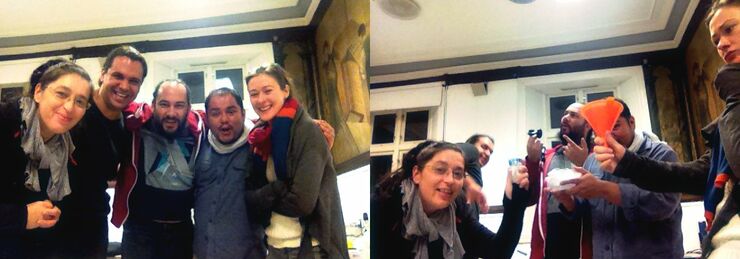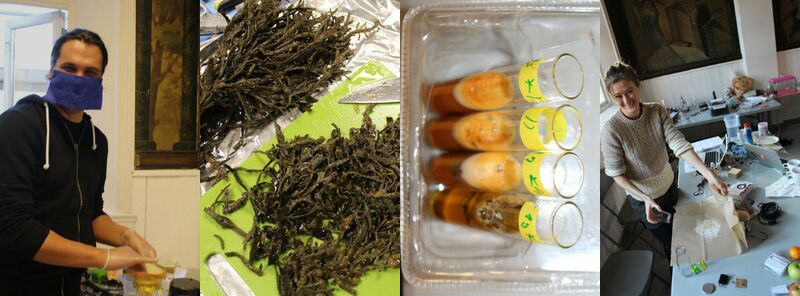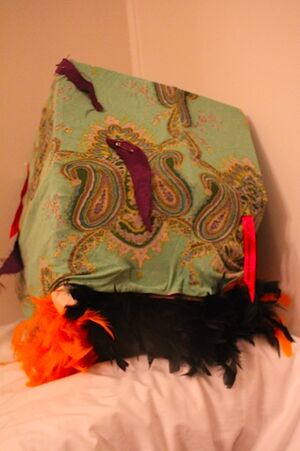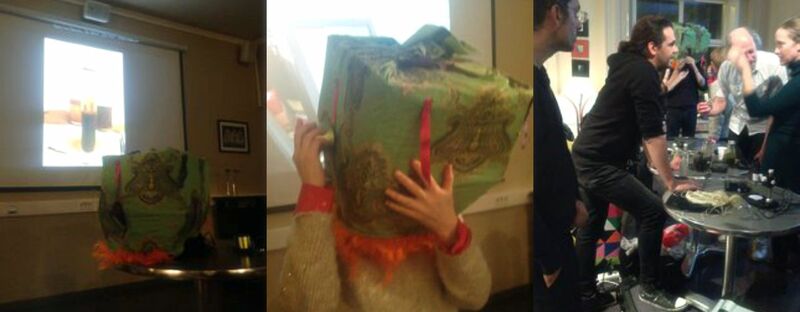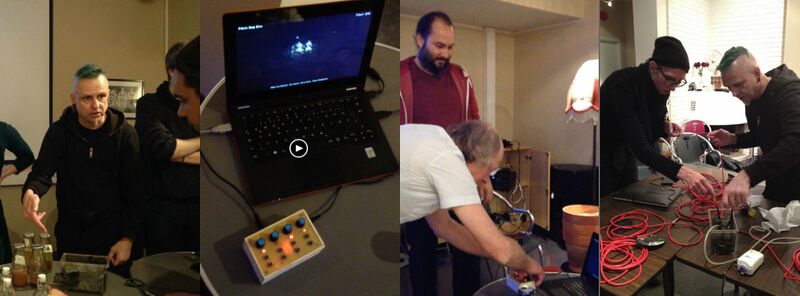Pikslo deep diving / underwater interception of the nordic sea
Pikslo_deep_diving / underwater interception of the nordic sea
DIWO open lab, DIY Biologie, DIY Chemistry, DIY hydrophone
Keywords
sonification, sound pollution, underwater sound, underwater sound pollution, anthropogenic
influence on the sea life, hydrophone, sonar, field recording, electromagnetic polution
(internet cables in water), acoustic ecology, seafaring, animals, fish, jellyfish, nordic sea, DIY
biologie, DIY chemistry, anthropocene, microplastic polution, interspecies empathy, embodiment, complex systems
Collaborators team:
Robertina Šebjanič (SI), Kat Austen (UK/DE), Slavko Glamočanin (SI), Gjino Šutić
(CRO), Piksel team (main organiser)
+
associated partner / mentor of the DIY bio workshop by Cristian Delgado
+
participants of the workshop
Workshop / project:
During the 5 day work intense inter disciplinary research of four main mentors and
collaborators did open the process of the exploration of the context of DIY biologie, DIY
chemistry and sound. An DIY laboratory in the context of the Piksel festival was the main eirviroment for the workshop.
We did spend time out on the field trips to
the fjords and surroundings in Bergen, to collect needed data.
Introduction to research / main topic of the research has been:
- underwater sound polution
- microplastic polution
Field trip - reaserch - collecting data
Harbour - collectiong data
17., 18., 19., 20. November 2015
Fjords boat trip - underwater recording
21. November 2015
gps locations of the audio recordings and the audio recordings coming soon...
DIY hydrophone
We build a lot of various DIY hydrophone with piezo speakers, to try them out on the field trips.
Audio summary and visualization - Pikslo Deep Dive visualization
4 hydrophone recordings we made in the sea around Bergen, Norway on 21.11.2015.
- First one is just outside the harbour (00:00),
- the second is a boat passing by on the same spot (00:42),
- third is in a secluded bay (01:19)
- fourth a point in the open (03:12).
Visualized by Slavko Glamočanin with OpenGL in realtime.
Thanks to http://www.ultranoise.es/ aka Enrique Tomas ] for lending us the professional hydrophone (which we compared to our DIY ones:)
Audio recordings available here: https://www.freesound.org/people/slavko321/packs/18501/
GPS locations of the audio recordings and the audio recordings coming soon...
.
Microplastic pollution - DIY bio and DIY chemistry research
Mareano programme, which records all instances of marine litter that the researchers find
http://mareano.no/en/about_mareano
http://mareano.no/en/maps/mareano_en.html
This has little information on the region around Bergen
Methods for analysing microplastics: http://marinedebris.noaa.gov/sites/default/files/publications-files/noaa_microplastics_methods_manual.pdf
Destroying organic compounds (for microplastic analysis):
https://en.wikipedia.org/wiki/Fenton's_reagent
(hydrogen peroxide + Fe solution)
we are using Sodium percarbonate instead of hydrogen peroxide
Venish has 30% sodium peroxide + enzimes (protein & starch digestion - protease & amylase)
http://rbeuroinfo.com/ - Venish composition
Water lab analysis out of the harbour
Temperatire 14 deg C
767 x10
760 x10
pH 6.6
ALGAE MICROPLASTIC TESTING PROTOCOL
Algal Samples:
Ascophyllum nodosum - formally identified as Fucus vesiculosus, known by the common name bladder wrack or bladderwrack (bubbles)
Oarweed or Kelp (Laminaria digitata) (flat without bubbles)
Fucus serratus (second sample from outside the harbour)
Testing protocol: 1 g of each type of algae into test tubes, 4 iterations of each Stock solution of vanish - 40 g to 80 mL water Stock Iron Solution 3.75g Fe II sulphate, 4g Mexican lemon salt powder (lemon juice, citric acid, salt and sugar), 250 ml water (boiled)
To 1g of each seaweed in a small test tube add: Sample 1: 5ml Fe 5ml Percarbonate
Sample 2: 5ml Fe II aq stock 5ml Percarbonate 0.5 ml of Ajax all purpose cleaning gel
Sample 3: 5ml Fe 5ml Percarbonate 2ml Ajax
Sample 4: 5ml Fe 10 ml 3% hydrogen peroxide solution
Left standing for 10 minutes Heat to 80 degrees C then turn off heat and leave to stand
Coral Empathy Device
Information from the DIY microplastic experimentation and conversations with researchers from Bergen's Marine Institute, alongside sound recordings from the hydrophone field trips, informed the design of a prototype Coral Empathy Device. The device obliterates the visual, employing sound, pressure, texture and smell to translate messages of anthropogenic marine intervention between the experience of coral in the Norwegian waters and the experience of humans on terra. Liquid to air, coral to human, the Coral Empathy Device prototype is an experiment in interspecies empathy.
Final Presentation
DIY BIO
associated partner / mentor of the DIY bio workshop by Cristian Delgado
DNK extraction etc... See video https://vimeo.com/146942782
Concept & context
Pikslo_deep_diving // Context & concept of the workshop / research:
by Robertina Šebjanič (SI), Kat Austen (UK/D), Slavko Glamočanin(SI), Gjino Šutić (CRO)
When we look up to sky and look into the space and wonder about what is up there, we
sometime forget, that there is a lot still also to explore on the planet we live.
We know more about the space than we know about the world’s seas and oceans,
especially about the sound perception underwater.
People are not so aware of the vibrant underwater acoustic of sounds of the deepness of
ocean, except for the crash of a wave against a land. Whales, shrimp, seals, dolphins, and a
variety of other creatures of the deep live in a watery acoustical sonic environment. The
arrival of steamships and other humanmade interventions into the ocean soundscape has
contributed disturbing noise to this rich soundscape.
The workshop / project encourage an interrelationship between sound, nature, and
society, as a starting point for the rethinking of the possible developed of nicer sonic
environments for the animals living in the world's oceans and sea’s.
The underwater sound pollution is the reality of recent development and industrialization
reflecting on the sea.
Especially the upper level of the seas where there is most of the living in the seas and
independent by the level of the sonic pollution in the sea. We would also try to research the
deep sea level to understand what is happening there.
World seas and oceans are presenting more than 70% of surface of Earth.
97% of it is saltwater, 2% is fresh water in the form of ice and only the remaining 1% is
drinking water, which is distributed around the planet very unevenly.
The exploration of any ecosystem requires detailed study and observation. The ocean is the
complex, challenging, and harsh environment on Earth and accessing it requires specially
designed tools and technology. It has only been within the last 50 years that technology has
advanced to the point that we can examine the ocean in a systematic, scientific, and non
invasive way. Our ability to observe the ocean environment and its resident creatures has
finally caught up with our imaginations and helping us to understand it also in the ways that
we did not imagine them before.
“Already back at the renaissance 1490 Leonardo da Vinci observed how the sound of ships
travelled long distances underwater. The sound of ships in the 15th century included the
noise of rudders and rigging, oars and the handling of cargo. Seafaring, while not in its
infancy, was a “life driven” technology; the power of wind and human muscle generated the
only anthropogenic noises in the sea. Over the next 400 years, acoustic technology at sea
involved innovations such as underwater bells and whistling buoys on submerged rocks and
reefs to warn navigators and captains away from marine hazards. With the advent of steam
powered engines, the quality and level of noise began to shift dramatically. With the ability to
navigate to, and develop the far reaches of the globe, the use of dynamite and diesel driven
pile drivers began transforming the soundscape of coastal waters worldwide. Once the
mechanization of seafaring and coastal civil engineering took hold, ocean noise began
increasing exponentially” * (from the Soundscape The Journal of Acoustic Ecology) and
it started to overtake also the sound scape environment of the animals.
More about the seas in Norway:
NOAA
https://www.nodc.noaa.gov/OC5/nordicseas/
Some of references and interesting readings for the context of the workshop:
from the referential journal: Soundscape The Journal of Acoustic Ecology and
NOAA’s
Marine Life
The sounds produced by marine animals are many and varied. Marine mammals, such as
blue whales and harbor porpoise, produce sounds over a wide frequency range, from less
than 10 Hz to over 100,000 Hz, depending on the species of marine mammal. Many fish,
such as the oyster toadfish and plainfin midshipman, and some marine invertebrates, such
as snapping shrimp, also produce sounds. Marine animals use sound to obtain detailed
information about their surroundings. They rely on sound to communicate, navigate, and
feed. Marine mammals, such as dolphins, use sound to locate and identify objects such as
food, obstacles, and other whales. By emitting clicks, or short pulses of sound, and listening
to the echo, dolphins can detect individual prey and navigate around objects underwater.
from the http://www.dosits.org/science/soundsinthesea/commonsounds/
Salt-Water Fish Extinction Seen By 2048
The apocalypse has a new date: 2048.
That's when the world's oceans will be empty of fish, predicts an international team of ecologists and economists. The cause: the disappearance of species due to overfishing, pollution, habitat loss, and climate change.
The study by Boris Worm, PhD, of Dalhousie University in Halifax, Nova Scotia, -- with colleagues in the U.K., U.S., Sweden, and Panama -- was an effort to understand what this loss of ocean species might mean to the world.
The researchers analyzed several different kinds of data. Even to these ecology-minded scientists, the results were an unpleasant surprise. http://www.cbsnews.com/news/salt-water-fish-extinction-seen-by-2048/
Cnidaria jellyfish hearing under the water
At present there is still a dearth of research and understanding about how Cnidaria—with
their ancient evolutionary history— actually perceive and adapt to their environment through
acoustic energy and vibration, and how this has enabled them to survive over the eons
despite their ‘simplicity.’
Marine mammal calls can actually increase ambient noise levels by 2025 underwater dB in
some locations at certain times of year. Blue and fin whales produce lowfrequency moans
at frequencies of 1025 Hz with estimated source levels of up to 190 underwater dB at 1 m.
The ambient noise levels at frequencies of 1720 Hz increase off coastal California during
the fall and winter months due to blue and fin whale calls.
from the Soundscape The Journal of Acoustic Ecology
http://wfae.proscenia.net/journal/scape_6.pdf
Animal Sound Perception and Production Modes
From the preceding it is clear that many sea animals use sound in a variety of ways. Some
animals use sound passively, others actively. Passive use of sound occurs when the animal
does not create the sound that it senses, but responds to environmental and ambient
sounds. These uses include: 1. Detection of predators. 2. Location and detection of prey. 3.
Proximity perception of cospecies in school, raft or colony. 4. Navigation—either local or
global. 5. Perception of changing environmental conditions such as seismic movement, tides
and currents. 6. Detection of food sources and feeding of other animals. 7. “Acoustic
illumination” akin to daylight vision. Active use of sound occurs when the animal creates a
sound to interact with their environment or other animals in it. Active uses include: 1. Sonic
communication with cospecies for breeding. 2. Sonic communication with cospecies for
feeding, including notification and guidance of others to food sources. 3. Territorial and
social relations. 4. Echolocation. 5. Stunning and apprehending prey. 6. Alarm calls used to
notify other creatures of the approach of enemies. 7. Long distance navigation and mapping.
8. Use of sound as a defense against predators. 9. Use of sound when seized by a predator
(perhaps to startle the predator).
from the Soundscape The Journal of Acoustic Ecology
http://wfae.proscenia.net/journal/scape_6.pdf
Arctic Hydroacoustics by H KUTSCHALEI
underwater sound are the permanent ice cover and the velocity structure in the water. ... Sounds are transmitted to great ranges in this natural arctic waveguide.
http://pubs.aina.ucalgary.ca/arctic/Arctic22-3-246.pdf
Underwater Sound Propagation in the Arctic Ocean
by H. W. Marsh and R. H. Mellen
Some results of a four‐year experimental study of sound propagation in the Arctic are presented and interpreted. The duration, form, and intensity of waves received at distances up to 1400 km are explained using ray theory and modes, in which source characteristics, refraction, scattering at the ice surface, and bottom effects are important.
http://scitation.aip.org/content/asa/journal/jasa/35/4/10.1121/1.1918531
308 million year old tropical forest in the arctic
A recent study published in the journal Geology shared some surprising findings: the icy landscape of Svalbard, Norway was once home to an ancient tropical forest. A group of researchers from Cardiff University found fossilized tree stumps belonging to lycopsids, a tropical tree, during the course of field work in the area.
http://inhabitat.com/scientists-discover-308-million-year-old-tropical-forest-in-the-arctic/
Video of plankton eating plastic
http://grist.org/list/this-beautiful-video-of-plankton-eating-plastic-is-also-a-little-disturbing/?utm_source=facebook&utm_medium=update&utm_campaign=socialflow
Killer whales make waves to hunt seals
A BBC film crew has captured footage of killer whales working together to create waves to wash their vulnerable prey into the water.
The predators targeted a weddell seal that was resting on a small ice floe, sweeping it off the ice to where they could attack it.
Scientists who worked with the film crew said the footage revealed new insights into killer whale ecology.
The team filmed the sequence for the BBC documentary Frozen Planet
http://www.bbc.co.uk/nature/15308790
Underwater Sound in the Arctic Ocean (reaserch from 1965)
http://www.dtic.mil/dtic/tr/fulltext/u2/718140.pdf
The underwater noise that drove scientists QUACKERS for 50 years:
Researchers discover minke whale is source of mysterious duck sound
http://www.dailymail.co.uk/sciencetech/article-2611606/The-underwater-noise-drove-scientists-QUACKERS-Researchers-discover-source-mysterious-duck-sound-minke-whales.html#ixzz3sVRwvTzD
You might not be able to see them, but microplastics are in the water—and our seafood:
[1]

